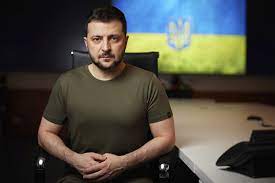
Ukraine is poised to recalibrate the dynamics of drone capabilities, marking a strategic shift vis-a-vis Russia. President Volodymyr Zelensky’s New Year’s Eve address unveiled plans to deploy one million drones to the Armed Forces of Ukraine by the close of 2024. This initiative positions 2,732 Ukrainian drones in active service each day, either in production or engaged in military operations.
In alignment with the national objective of bolstering self-sufficiency, Ukraine, as articulated by Minister of Strategic Industries Oleksandr Kamishin on December 27, aims to amplify local military production significantly. Termed the “engine of economic recovery,” the goal is to augment manufacturing capacity sixfold, underscoring Kyiv’s strategic blueprint.
Targeting the Core
Ukraine’s industrial complex is increasingly becoming a focal point. Recent and prospective Russian offensives in 2023 and 2024 prioritize not only Ukraine’s energy infrastructure but also target defense sector enterprises. This perspective, articulated by Moscow, finds validation in intelligence assessments from London, UK. British intelligence underscores Russia’s recalibrated focus on military factories, munitions depots, and analogous facilities, signaling a strategic acknowledgment of the growing importance of defense industry competencies in an anticipated protracted conflict.
Ongoing Drone Warfare
The proclamation of the production of the one-millionth Ukrainian drone hints at an impending year dominated by drone warfare, akin to the trends observed in 2023. Should Ukraine fulfill its committed drone quantity, it is anticipated that it could narrow the production gap with Russia and potentially surpass it at a later stage. It is noteworthy that the current Russian industry output stands at 1,000 drones daily, with projections indicating a commensurate increase in production relative to Ukraine. The unfolding drone-centric landscape underscores the evolving dynamics of the ongoing geopolitical and military standoff.
In the upcoming year, the spotlight will illuminate FPV drones, known for their cost-effectiveness and rapid production capabilities. These drones, designed for a specific purpose, exhibit a short operational lifespan as they are utilized for self-detonating missions against enemy armored vehicles, enemy positions, or heavy artillery systems.
Russia Shifting Tactics
Amidst these developments, the Russian Federation is adapting its tactics in response. Ukrainian sources report a discernible change in Russian missile attacks in recent days. According to a Ukrainian general, the Russian military is employing a sequential firing strategy, launching multiple missiles at the same target in succession rather than simultaneously. The strategic objective is to concentrate strike power where air defense systems such as Patriot, NASAMS, or IRIS-T may be deployed.
Ukrainian Perspectives
Ukrainian authorities contend that this tactic stems from concerns that Ukrainian batteries might be unable to counter the successive strikes due to a purported lack of ammunition. Contrary to these claims, Ukrainian sources assert that there is still an ample supply of ammunition available.
Ammunition Shortage Reality
Recent information aligns with the Ukrainian General Sergei Naev’s warning about a severe shortage of ammunition in the country’s air defense system. During a visit to troops near Kyiv, General Naev conveyed to AFP that the existing ammunition for Ukraine’s mobile air defense platforms must endure the anticipated intense confrontations. Looking forward, Ukraine acknowledges its reliance on Western nations for the replenishment of missile arsenals, with a primary focus on securing additional ammunition to sustain its air defense capabilities in the medium to long term.
“Of course, we are eager for additional missiles for the Patriot systems and the systems themselves,” expressed the head of the United Ukrainian Armed Forces, who is responsible for mobile air defense units in the capital, Kyiv, and in Northern Ukraine. He was referring specifically to the US Defense Patriot systems. This is because Russian forces are striving to “truly deplete the air defense system.”
Given the substantial and forceful Russian offensive against Ukraine at the beginning of the year, Kyiv’s perspective emphasizes the critical need to accelerate the Western provision of air defense systems, combat drones, and medium-range missiles.




